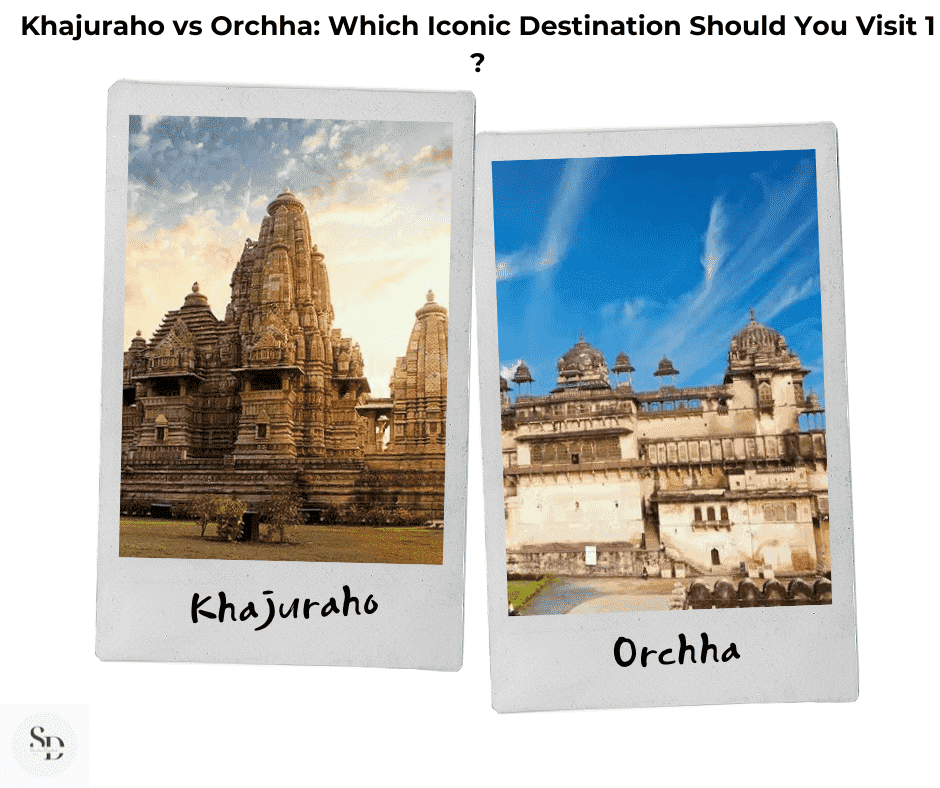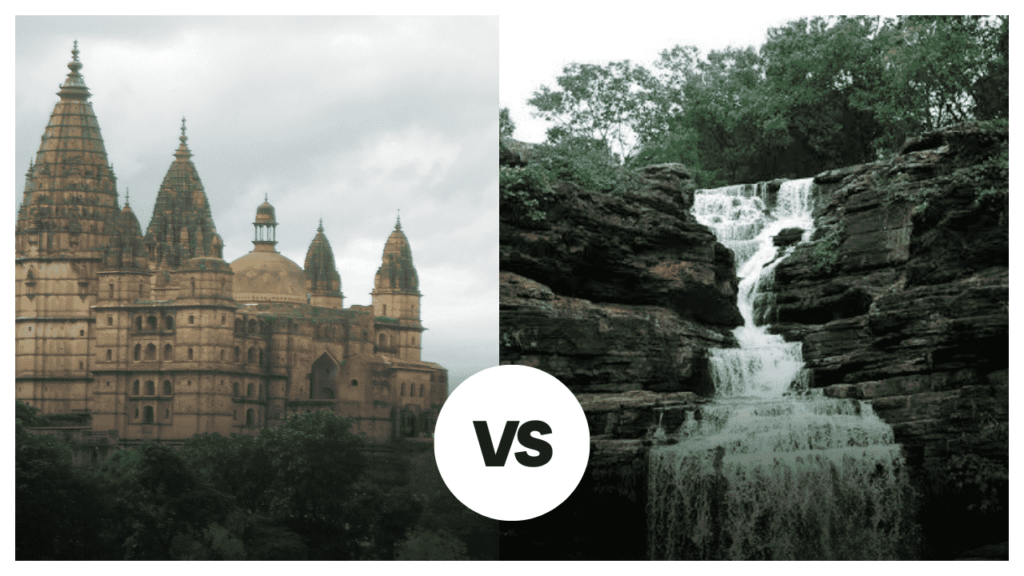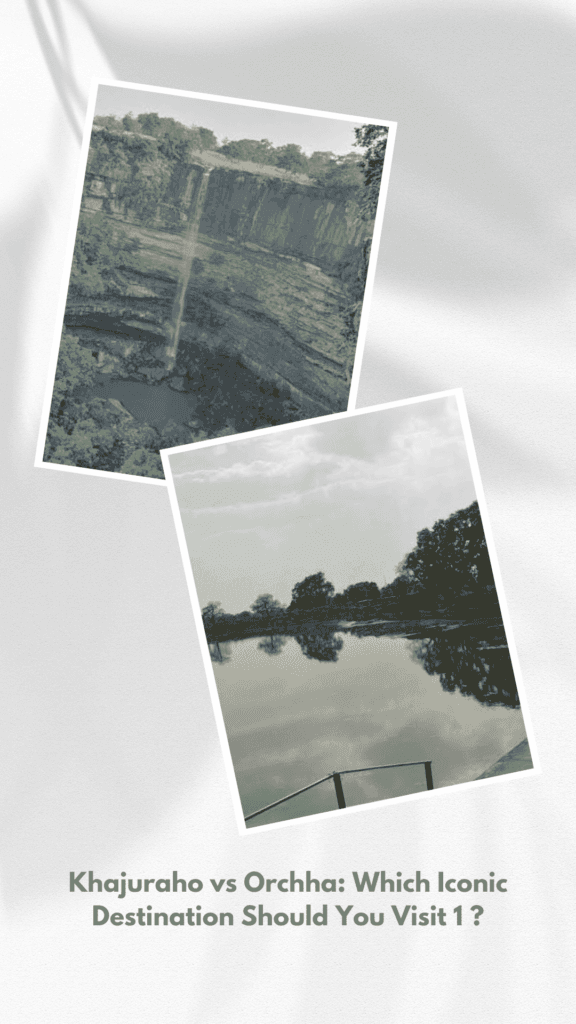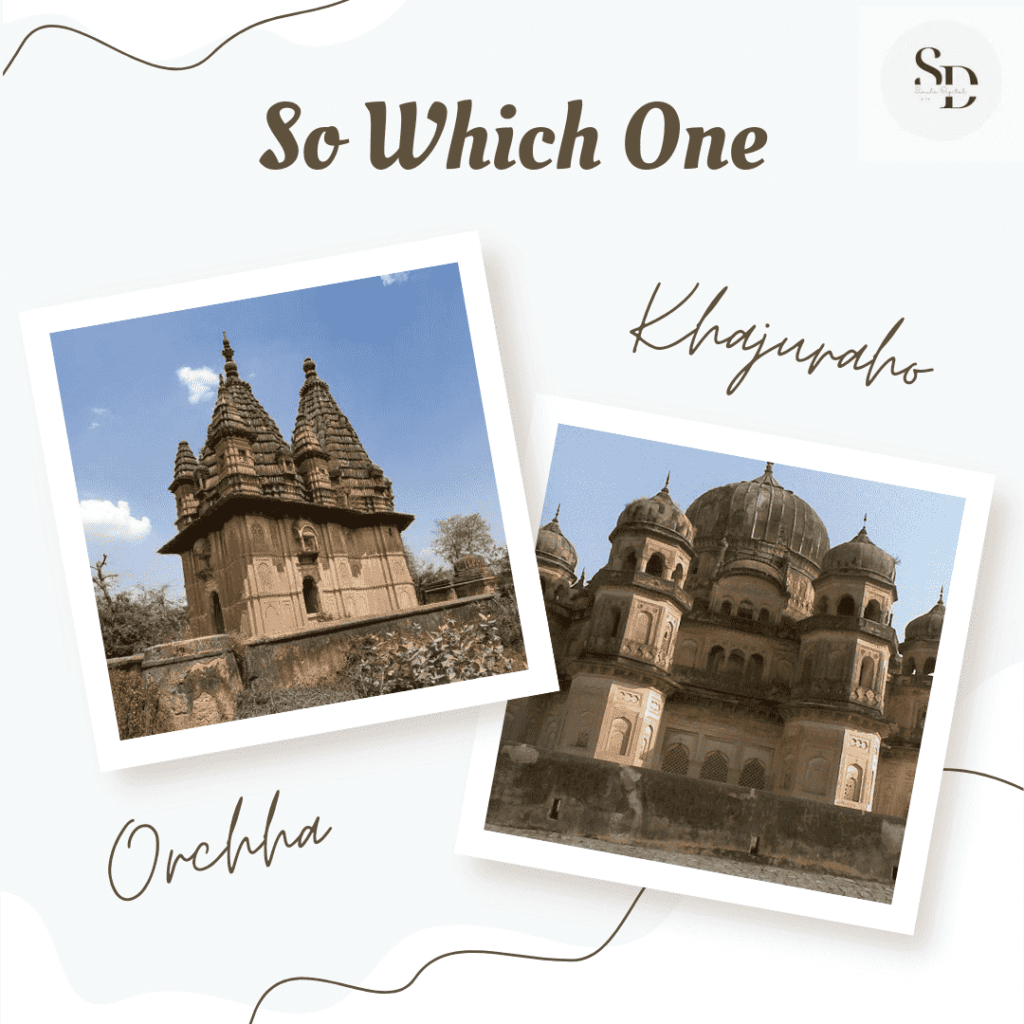Khajuraho vs Orchha: Which Iconic Destination Should You Visit 1 ? – Discover the timeless allure of Khajuraho and Orchha, two of Madhya Pradesh’s most iconic destinations. Whether you’re drawn to Khajuraho’s intricate temples or Orchha’s majestic palaces and forts, this guide compares both to help you decide which heritage-rich site should be at the top of your travel list. Explore their unique architecture, history, and cultural significance to make your next trip unforgettable.
Table of Contents
Introduction and origin
When it comes to heritage destinations in Madhya Pradesh, Khajuraho and Orchha stand out as two of the most captivating locations. Both boast centuries-old architecture, rich cultural legacies, and awe-inspiring landmarks. However, these two gems offer vastly different experiences. While Khajuraho is renowned for its magnificent temples adorned with intricate sculptures, Orchha is celebrated for its grand palaces and formidable forts that echo with the stories of past rulers.

Choosing which destination to visit first can be a tough decision, especially for history buffs, architecture lovers, and curious travelers alike. This article delves into the highlights of Khajuraho and Orchha, comparing their origins, history, and significance, to help you determine which place deserves a spot on your itinerary first.
Khajuraho: Origin and Background
Khajuraho, situated in the Chhatarpur district of Madhya Pradesh, is a small town with an outsized reputation for its ancient temple complex. The town was once the capital of the Chandela dynasty, which ruled central India during the 10th and 11th centuries. Khajuraho’s name is believed to derive from the Hindi word “khajur,” meaning date palms, which once surrounded the area.
At its height, Khajuraho was home to 85 temples, but today, around 25 remain, making it a UNESCO World Heritage Site and one of India’s most visited destinations. The Khajuraho temples are famous for their intricate stone carvings, which depict everything from mythological stories to daily life and, most famously, erotic sculptures that symbolize the celebration of love, life, and devotion.
Orchha: Origin and Background
Orchha, located in the Niwari district along the banks of the Betwa River, has a charm that blends natural beauty with architectural grandeur. Founded in 1531 by Rudra Pratap Singh, a Bundela Rajput king, Orchha served as the capital of the powerful Bundela kingdom. The name Orchha translates to “hidden,” and true to its name, this town was relatively unknown for centuries until travelers rediscovered its magnificence.
Orchha is home to an array of impressive structures such as the Orchha Fort, Jahangir Mahal, and Ram Raja Temple. It’s not just the architecture that captivates visitors—Orchha also offers a peaceful ambiance with its serene riverside location and surrounding greenery. The town has a slower pace compared to the bustling cities, making it ideal for those seeking a blend of history, culture, and relaxation.
History of Khajuraho
Khajuraho’s history dates back to the Chandela dynasty, which ruled central India between the 9th and 13th centuries. The Chandelas were great patrons of art and culture, and under their reign, Khajuraho became a major cultural and religious hub. The temples at Khajuraho were built between 950 and 1050 AD and reflect a fusion of Hindu, Jain, and Tantric traditions.
One of the fascinating aspects of Khajuraho is its decline and rediscovery. After the Chandela dynasty faded, the temples were abandoned and left to be overtaken by the surrounding forests. For centuries, Khajuraho remained hidden until British explorer T.S. Burt stumbled upon the temples in the 1830s, reviving global interest in this architectural masterpiece.
History of Orchha
Orchha’s history is deeply tied to the Bundela Rajputs, who ruled the region during the 16th and 17th centuries. The kingdom of Orchha was founded by Rudra Pratap Singh, and under the leadership of his successors, the town flourished as a cultural and political center. Orchha’s strategic location along the Betwa River also made it an important trade route, which contributed to its growth.
One of the town’s most significant moments was its interaction with the Mughal Empire. The magnificent Jahangir Mahal was built to honor Emperor Jahangir’s visit to Orchha in 1606, reflecting the strong ties between the Bundelas and the Mughals. Despite its historic prominence, Orchha gradually declined after the capital was moved to Tikamgarh. However, its stunning architectural legacy remains intact, drawing history enthusiasts and travelers to this day.
Comprehensive comparison of Khajuraho and Orchha based on various factors
1. Architecture
Khajuraho: Famous for its temples, Khajuraho is known for its intricate and detailed carvings, especially the erotic sculptures on the exterior walls of the temples. The architecture is a fine example of the Nagara-style temple architecture, blending spirituality, sensuality, and artistic grandeur. The Kandariya Mahadeva Temple, Lakshmana Temple, and Chaturbhuj Temple are some prime examples.
Orchha: In contrast, Orchha’s architecture reflects the strength and grandeur of the Bundela rulers. The massive forts and palaces here are a blend of Rajput and Mughal architectural styles, with the Orchha Fort Complex, Jahangir Mahal, and Raj Mahal showcasing magnificent arches, domes, and symmetrical layouts. The buildings are more focused on military strength and regal elegance.
2. Religious Significance
Khajuraho: A stronghold of Hinduism and Jainism during the Chandela period, Khajuraho is deeply religious. The temples are dedicated to deities like Shiva, Vishnu, and Jain Tirthankaras. Though these temples are now monuments, they are revered for their spiritual connection and the sacredness of the carvings.
Orchha: Orchha holds immense religious significance, particularly due to the Ram Raja Temple, the only place where Lord Rama is worshipped as a king rather than a god. This temple is the heart of Orchha’s religious activity and draws thousands of devotees. The Chaturbhuj Temple is another religious site with historical significance.
3. Historical Importance
Khajuraho: As a UNESCO World Heritage Site, Khajuraho’s historical importance is tied to its role as a religious and cultural hub during the Chandela dynasty. The temples provide invaluable insight into the lifestyle, beliefs, and artistic capabilities of that era.
Orchha: Orchha’s history is dominated by its role as the capital of the Bundela kingdom. The town played a significant part in the region’s politics, especially its alliance with the Mughal Empire. Monuments like the Jahangir Mahal tell stories of royal hospitality and Mughal-Rajput diplomacy.
4. Cultural Influence
Khajuraho: Khajuraho has had a lasting impact on Indian culture, particularly through its artistic representation of human emotions, love, and spirituality. It serves as a critical source for understanding ancient Indian rituals, social structure, and aesthetic preferences.
Orchha: The cultural legacy of Orchha is rooted in its royal heritage and its long-standing devotion to Lord Rama. Festivals like Ram Navami are celebrated with great fervor here, drawing pilgrims from across India. The town also boasts a deep connection to Bundela traditions and Rajput valor.
5. Tourist Attractions
Khajuraho: Aside from the temples, Khajuraho offers attractions like the Archaeological Museum and the Sound and Light Show that narrates the town’s history. Visitors are drawn to the vivid, detailed temple carvings that depict life during the Chandela period.
Orchha: Orchha’s fort complex is its primary attraction, consisting of the Raja Mahal, Jahangir Mahal, and the royal cenotaphs (chhatris) that line the Betwa River. Visitors also enjoy the peaceful setting of the town, including boating and wildlife spotting at the Orchha Nature Reserve.

6. Geography
Khajuraho: Located in the Vindhya Range, Khajuraho is a relatively flat area, surrounded by small hills and forests. Its geographical isolation contributed to its rediscovery, as it was hidden under dense forest for centuries.
Orchha: Nestled along the Betwa River, Orchha offers a scenic landscape of rivers, hills, and forests. The town’s location adds to its charm, offering tranquility and opportunities for outdoor activities like river rafting and trekking.
7. Weather Conditions
Khajuraho: Khajuraho experiences a tropical climate with hot summers, monsoons, and mild winters. The best time to visit is during the winter months (October to February) when the weather is pleasant for sightseeing.
Orchha: Orchha shares a similar climate with Khajuraho but tends to be slightly more temperate due to its riverside location. The winter months are also ideal for visiting Orchha, with cool, comfortable weather.
8. Accessibility
Khajuraho: Khajuraho is relatively easy to access with an airport that connects it to major cities like Delhi and Varanasi. It’s also accessible by train and road, though its location in central India means longer travel times for some tourists.
Orchha: Orchha is well-connected by road and is only a few kilometers away from Jhansi, a major railway hub. Although it doesn’t have its own airport, the proximity to Jhansi makes it accessible for travelers by train or car.
9. Tourist Infrastructure
Khajuraho: Being a world-famous tourist destination, Khajuraho has a well-developed tourist infrastructure. There are several hotels, resorts, and restaurants catering to international and domestic tourists. The town also hosts an annual dance festival that attracts visitors from all over the world.
Orchha: Orchha’s tourist infrastructure is less developed compared to Khajuraho, but it offers a charming mix of mid-range hotels, homestays, and guesthouses. Its quieter ambiance is ideal for travelers looking for a more laid-back experience. There are also a few resorts that cater to high-end visitors.
10. Local Markets and Shopping
Khajuraho: Khajuraho is known for its handicrafts, including stone sculptures, brassware, and traditional Madhya Pradesh textiles. The local markets offer a range of souvenirs for tourists, with shops often centered around the temple complexes.
Orchha: Orchha’s markets are smaller but offer unique crafts like hand-painted postcards, paintings, and Bundela-style textiles. It’s a more intimate shopping experience, with artisans often selling their goods directly to tourists.

11. Cultural Events and Festivals
Khajuraho: The Khajuraho Dance Festival is the biggest cultural event in the town, held annually in February. It showcases classical Indian dance forms against the backdrop of the illuminated temples, providing an enchanting blend of art and history.
Orchha: Orchha’s Ram Navami celebration is a grand festival where thousands of devotees gather at the Ram Raja Temple. The town comes alive with religious processions and ceremonies that honor Lord Rama.
12. Nearby Attractions (Within 100 km)
Khajuraho: Panna National Park, known for its tiger reserve, is a popular excursion from Khajuraho. The Raneh Falls and Ken Gharial Sanctuary are also close by, offering natural beauty to complement the historical attractions.
Orchha: Jhansi, a city steeped in history, is just 16 km away, making it an easy day trip for visitors to Orchha. The town also offers nature-based activities like river rafting on the Betwa and exploring the Orchha Wildlife Sanctuary.
13. Education and Learning
Khajuraho: While primarily a tourist destination, Khajuraho does offer learning experiences for those interested in ancient Indian architecture and art history. The temples provide a wealth of knowledge for scholars studying the Chandela period.
Orchha: Orchha offers insights into Bundela history and Mughal-Rajput relations. It is a prime location for historians and students of medieval Indian history, particularly those interested in the dynamics between regional kingdoms and the Mughal Empire.
14. Tourist Demographics
Khajuraho: Khajuraho attracts a global audience due to its UNESCO status, with tourists coming from all over the world to marvel at the unique temple sculptures. It caters to both domestic and international visitors with its wide range of services.
Orchha: Orchha attracts primarily domestic tourists, though international travelers do visit, drawn by its tranquil ambiance and rich history. It’s popular among pilgrims, history buffs, and those looking for an off-the-beaten-path destination.
15. Unique Selling Point
Khajuraho: The temples of Khajuraho are unparalleled in the world for their intricate sculptures, artistic mastery, and the sheer scope of their cultural significance. They offer an immersive experience into India’s religious and artistic history.
Orchha: Orchha’s serene setting, combined with its royal architecture, offers a peaceful and reflective experience. The blend of Mughal and Rajput architecture sets it apart, providing a unique glimpse into Bundela history amidst natural beauty.
Some additional factors to compare Khajuraho and Orchha
1. Infrastructure Development
Khajuraho: As a globally recognized UNESCO World Heritage Site, Khajuraho has seen considerable investment in infrastructure to accommodate tourists. The town has well-developed roads, reliable electricity, and access to clean drinking water. Hotels, restaurants, and tourism-related facilities are well-established, catering to both luxury and budget travelers. However, the local town infrastructure beyond the main tourist area is less developed compared to larger cities.
Orchha: Orchha’s infrastructure has also been improved to boost tourism, but it remains somewhat limited compared to Khajuraho. The town’s roads, while motorable, are not as well-maintained. Power supply and basic amenities are available, though not as abundant as in Khajuraho. The hospitality sector in Orchha is growing, but it remains a quieter, more traditional destination.
2. Hospitality and Accommodation
Khajuraho: Being a major tourist hub, Khajuraho offers a wide range of accommodation, from luxury hotels and resorts to budget-friendly lodges and homestays. International hotel chains and upscale resorts offer premium experiences for visitors. There are numerous restaurants, cafes, and eateries catering to both local and international cuisine.
Orchha: Orchha, though smaller, has a growing hospitality sector. It offers heritage hotels, including the famous Sheesh Mahal Hotel, along with more modest guesthouses and lodges. The accommodations are more limited compared to Khajuraho, but the town retains a charming, laid-back vibe. The food scene in Orchha includes local Bundeli cuisine and some multi-cuisine options for tourists.
3. Population and Demographics
Khajuraho: The population of Khajuraho is relatively small, estimated at around 24,000 people. The economy is largely driven by tourism, with locals engaged in services such as hospitality, guiding, and selling local crafts. The town also has a small agricultural sector.
Orchha: Orchha is a much smaller town with a population of roughly 8,500 people. Like Khajuraho, its economy revolves around tourism, though it also has a significant local population engaged in farming and traditional trades. The community is tightly knit, and visitors can experience a more intimate cultural interaction here.
4. Air Connectivity
Khajuraho: Khajuraho is well-connected by air, with Khajuraho Airport offering direct flights to major cities like Delhi and Varanasi. The airport is located just 4 km from the town, making it convenient for tourists.
Orchha: Orchha does not have an airport. The nearest airport is Gwalior Airport, located about 120 km away, or Khajuraho Airport at a distance of 178 km. Tourists traveling by air will need to use these airports and then travel to Orchha by road.

5. Road and Bus Connectivity
Khajuraho: Khajuraho is well-connected by road, with good highways linking it to cities like Jhansi, Satna, and Panna. Both private and state-run buses operate regular services, making it accessible for road travelers.
Orchha: Orchha’s connectivity by road is decent, though slightly less developed than Khajuraho. It is located just 16 km from Jhansi, a major transport hub. Buses and taxis frequently run between Orchha and nearby towns like Jhansi, Gwalior, and Chhatarpur.
6. Train Connectivity
Khajuraho: Khajuraho has a railway station, Khajuraho Railway Station, which connects the town to several major cities including Delhi, Agra, and Varanasi. The frequency of trains is moderate but increasing, reflecting the town’s tourism importance.
Orchha: While Orchha does not have its own railway station, it is located near Jhansi Junction, a major railhead with excellent connectivity across India. Jhansi is a short 15-20 minute drive from Orchha, and from there, you can catch trains to cities like Delhi, Mumbai, and Kolkata.
7. Local Transportation and Mobility
Khajuraho: Local transportation within Khajuraho includes auto-rickshaws, cycle-rickshaws, and taxis. It’s a small town, so many visitors choose to explore on foot or by bicycle, which can be rented locally.
Orchha: Orchha has a more laid-back transportation system, with fewer taxis and auto-rickshaws compared to Khajuraho. Most tourists prefer walking or hiring bicycles to get around. Public transportation options are minimal, but taxis can be arranged for trips to nearby Jhansi or other attractions.
8. Cleanliness and Environmental Consciousness
Khajuraho: The town is relatively clean, especially around the temple complexes, as it attracts a large number of foreign tourists. The local authorities ensure the cleanliness of the main tourist areas, though the outskirts may lack the same attention.
Orchha: Orchha is a smaller, quieter town, and the cleanliness standards are slightly lower compared to Khajuraho. However, the riverside areas and temple complexes are generally well-maintained. The Betwa River plays a central role in Orchha’s ecosystem, so the town is slowly adopting eco-friendly tourism practices.
15 Visiting Places Within 100 km of Khajuraho
1. Panna National Park (25 km)
A famous tiger reserve, perfect for wildlife enthusiasts looking to spot tigers, leopards, and other exotic species.
2. Raneh Falls (22 km)
A scenic waterfall located near the Ken River, known for its deep canyon of colorful granite rocks.
3. Ken Gharial Sanctuary (22 km)
Located near Raneh Falls, this sanctuary is home to the endangered gharial (fish-eating crocodile) and offers a great wildlife experience.
4. Pandav Falls (34 km)
A picturesque waterfall located in Panna, with mythological links to the Pandavas from the Mahabharata.
5. Ajaygarh Fort (80 km)
A historic fort perched on a hilltop, offering stunning views of the surrounding landscape and a peek into ancient defense architecture.
6. Brihaspati Kund (45 km)
A natural crater lake, ideal for a peaceful outing surrounded by rugged terrain.
7. Dhuba Dham (50 km)
A local spiritual and picnic spot, famous for its natural beauty and connection to the Dhuba River.
8. Mastani Mahal (30 km)
A palace built by Bajirao Peshwa for his lover Mastani, located in the town of Dhubela.
9. Kalinjar Fort (95 km)
A significant historical fort, once ruled by the Chandela dynasty, and associated with famous Indian legends.
10. Ragunathji Temple (50 km)
A temple dedicated to Lord Ram, known for its peaceful atmosphere and religious importance.
11. Shiv Temple in Majhgawan (60 km)
A lesser-known temple dedicated to Lord Shiva, set amidst beautiful natural surroundings.
12. Rajgarh Palace (75 km)
A historic palace from the Bundela era, offering insights into royal life and architecture.
13. Baldev Ji Temple, Naugarh (65 km)
A religious site known for its unique festivals and vibrant local culture.
14. Vishwanath Temple, Panna (45 km)
A temple dedicated to Lord Shiva, an example of medieval architecture in the region.
15. Diamond Mines of Panna (45 km)
Panna is known for its diamond mines, and visitors can explore the history and ongoing mining activities in the region.
Nearby City to Khajuraho
Panna (45 km): Known for its tiger reserve and diamond mines, Panna is the nearest city of historical and geographical importance to Khajuraho.
15 Visiting Places Within 100 km of Orchha
1. Jhansi Fort (16 km)
A symbol of the 1857 Rebellion, this fort offers insights into the history of India’s fight for freedom.
2. Datia Palace (34 km)
Also known as Bir Singh Palace, it is one of the finest examples of 17th-century Indian architecture.
3. Barua Sagar (24 km)
A peaceful lake and fort, offering a great spot for history lovers and nature enthusiasts alike.
4. Chaturbhuj Temple, Jhansi (16 km)
A large temple dedicated to Lord Vishnu, known for its impressive architecture and spiritual significance.
5. Rani Mahal, Jhansi (15 km)
The palace of Rani Lakshmibai, this site is rich in history and gives a glimpse into the queen’s life.
6. Shiv Mandir, Orchha Wildlife Sanctuary (8 km)
A small, serene temple located inside the Orchha Nature Reserve, offering peace and connection with nature.
7. Pitambara Peeth, Datia (35 km)
A famous temple dedicated to Goddess Pitambara, attracting pilgrims from across India.
8. Gwalior Fort (100 km)
One of India’s most formidable forts, known for its grand architecture and deep historical importance.
9. Rai Praveen Mahal (1 km)
A palace inside Orchha Fort dedicated to the famous poetess and singer, Rai Praveen.
10. Sunder Mahal (1 km)
A monument built by Prince Dhurjban who became a Muslim saint, reflecting Orchha’s historical and cultural diversity.
11. Laxminarayan Temple (2 km)
A unique temple combining elements of fort and temple architecture, offering murals from the 18th century.
12. Urai Town (80 km)
A lesser-known destination, famous for its local handicrafts and markets.
13. Raghunathji Temple, Shivpuri (95 km)
A religious site known for its historical connection to the royal families of the region.
14. Tarawali Fort (65 km)
A historic site, known for its stunning views and fortifications, providing a glimpse into ancient Orchha’s defense strategies.
15. Madhav National Park (90 km)
A wildlife sanctuary near Shivpuri, known for its rich biodiversity, scenic beauty, and opportunities for birdwatching and wildlife photography.
Nearby City to Orchha
Jhansi (16 km): A historically significant city known for its role in the 1857 Rebellion, it serves as a major connecting point and is rich in cultural heritage and monuments like Jhansi Fort and Rani Mahal.
Things to Do in Khajuraho
1. Explore the Khajuraho Group of Temples
The main highlight of Khajuraho is its UNESCO-listed temples. Visit the Western, Eastern, and Southern groups of temples, with notable ones including Kandariya Mahadev Temple, Lakshmana Temple, and Parsvanath Temple. Marvel at the detailed erotic sculptures and intricate carvings that depict daily life, mythology, and divinity.
2. Attend the Khajuraho Dance Festival
If you’re visiting in February, don’t miss the annual Khajuraho Dance Festival, a week-long celebration of classical Indian dance forms like Kathak, Bharatnatyam, Odissi, and more. The festival is held against the backdrop of the temples, adding to the grandeur of the performances.
3. Experience the Light and Sound Show
Held every evening at the Western Group of Temples, this show highlights the history, mythology, and architectural importance of Khajuraho. The beautifully lit temples in the evening add to the allure of the experience.
4. Wildlife Safari at Panna National Park
Just a short drive from Khajuraho, Panna National Park offers thrilling wildlife safaris where you can spot tigers, leopards, deer, and many bird species. The park is also home to the Ken River, where you can enjoy serene boat rides.
5. Visit Raneh Falls and Ken Gharial Sanctuary
Raneh Falls, located about 22 km from Khajuraho, is a stunning natural attraction with deep gorges and colorful granite formations. Nearby, the Ken Gharial Sanctuary is perfect for spotting the endangered gharial (a type of crocodile) in its natural habitat.
6. Try Local Cuisine
Don’t miss out on the local flavors of Madhya Pradesh. In Khajuraho, you can try delicacies like Bhutte ki Kees (corn dish), Poha, Sabudana Khichdi, and local sweets like Jalebi and Imarti. There are many cafes and restaurants near the temple complexes offering both local and continental food.

7. Explore the Tribal Art and Craft Scene
Khajuraho has several shops and markets where you can buy traditional tribal art, crafts, and souvenirs. Look out for handwoven textiles, wooden artifacts, and pottery.
8. Bicycle Tours Around Khajuraho
Khajuraho is a small town, and renting a bicycle is one of the best ways to explore the temple complexes and surrounding areas. You can ride through the scenic roads, interact with locals, and enjoy the tranquil countryside.
9. Visit the Adivart Tribal and Folk Art Museum
For a deeper understanding of the local culture, this museum exhibits the artwork and artifacts of the tribal communities of Madhya Pradesh, giving visitors insight into the region’s folk traditions.
10. Boating at Benisagar Lake
Enjoy a peaceful boat ride at Benisagar Lake, located on the outskirts of Khajuraho. The lake is a popular spot for locals and tourists to relax and enjoy the natural beauty.
Things to Do in Orchha
1. Visit Orchha Fort Complex
The Orchha Fort Complex is home to stunning architecture and monuments like the Jahangir Mahal, Raj Mahal, and Rai Praveen Mahal. Explore these grand palaces and enjoy panoramic views of the Betwa River and surrounding forests from the fort’s ramparts.
2. Chaturbhuj Temple and Ram Raja Temple
Chaturbhuj Temple is a magnificent temple dedicated to Lord Vishnu, known for its grand architecture. The Ram Raja Temple is unique as it is the only place in India where Lord Ram is worshipped as a king. The temple has a regal atmosphere and attracts devotees from across the country.
3. Take a Riverside Stroll Along the Betwa River
Orchha’s scenic beauty lies in its riverside location. You can walk along the banks of the Betwa River, take a dip in the holy waters, or even enjoy a boat ride. The riverfront is especially beautiful during sunrise and sunset.
4. Orchha Wildlife Sanctuary
Located just across the Betwa River, the Orchha Wildlife Sanctuary is a great spot for nature lovers. You can go birdwatching and spot various species like peacocks, vultures, and more. The sanctuary also offers opportunities for jungle walks and riverbank picnics.
5. Attend the Dussehra Festival
Orchha celebrates Dussehra with great enthusiasm, and the Ram Raja Temple plays a key role in the festivities. The town comes alive with vibrant decorations, processions, and cultural performances, making it an exciting time to visit.
6. Marvel at the Cenotaphs of Orchha
The Chhatris or cenotaphs of Orchha are beautiful monuments built in memory of the Bundela kings. These 14 cenotaphs are located on the banks of the Betwa River and are a popular spot for photographers and history buffs.
7. Explore the Local Markets and Handicrafts
Orchha’s local markets are filled with traditional handicrafts like stone carvings, metalwork, and textiles. You can shop for souvenirs and local artifacts, especially near the fort and temple areas.
8. Relax at Sheesh Mahal
Sheesh Mahal, now a heritage hotel, offers a royal experience where you can enjoy local cuisine while surrounded by beautiful Mughal and Bundela architecture. You can also book a stay to experience the luxury of the Bundela kings.
9. Try Local Food
Orchha’s food scene offers traditional Bundeli cuisine. Dishes like Bundeli Gosht, Kadhi, Baati, Lapsi, and desserts like Malpua are must-try. You’ll also find street food vendors offering local snacks like Samosa, Kachori, and Chaat.

10. Take a Heritage Walk
Orchha offers organized heritage walks that take you through the historical sites of the town, explaining the significance of each monument. It’s a great way to learn about the history of the Bundela dynasty.
11. Attend Evening Aarti at Ram Raja Temple
The evening aarti at the Ram Raja Temple is a serene and spiritual experience. Devotees gather to sing hymns, and the temple is lit up, creating a divine atmosphere.
12. Camping and River Rafting on the Betwa River
For adventure seekers, Orchha offers river rafting on the Betwa River during the monsoon season. There are also camping spots along the river, allowing visitors to enjoy the beauty of nature up close.
13. Visit Datia Palace
Located about 34 km from Orchha, Datia Palace (also known as Bir Singh Palace) is one of the finest examples of Mughal-Bundela architecture. It’s a great day trip from Orchha.
14. Explore Sunder Mahal
Sunder Mahal is a lesser-known attraction, but its story is significant. It was built by Prince Dhurjban, who became a Muslim saint after renouncing his princely life. The monument reflects the syncretic culture of the time.
15. Birdwatching at the Orchha Wildlife Sanctuary
The sanctuary is home to various migratory and resident birds, making it a paradise for birdwatchers. Species like kingfishers, vultures, and owls can be spotted.
Conclusion
Khajuraho and Orchha, two remarkable destinations in Madhya Pradesh, each offer a unique blend of history, culture, and natural beauty. Khajuraho is renowned globally for its UNESCO World Heritage temples, which showcase intricate art and architecture from the Chandela dynasty. Visitors are drawn to its spiritual significance, as well as the surrounding natural wonders like Panna National Park and Raneh Falls. Orchha, on the other hand, stands as a testimony to Bundela architectural brilliance, with grand palaces, temples, and forts, all nestled along the Betwa River. Its proximity to Jhansi further adds historical depth, especially for those interested in India’s colonial past and the freedom struggle.
While Khajuraho appeals to those fascinated by ancient architecture and sculpture, Orchha enchants visitors with its regal history and serene riverfront. Depending on your preferences—whether it be delving into India’s spiritual past or exploring the legacy of warrior kings—either destination provides a memorable experience. Both towns are ideal for those seeking to connect with India’s rich heritage, making them must-visit destinations for history buffs, culture enthusiasts, and nature lovers alike.

Thank You Note
Thank you for taking the time to explore this detailed comparison of Khajuraho and Orchha. Both of these remarkable destinations offer rich historical, cultural, and natural experiences, making them must-visit places for travelers in India. Whether you’re drawn to the exquisite temple sculptures of Khajuraho or the regal charm of Orchha’s palaces and forts, your journey is sure to be unforgettable. We hope this guide helps you plan your next adventure and enriches your understanding of Madhya Pradesh’s incredible heritage. Safe travels!
For more comparisons and insights, visit our blog regularly. If you have any questions or suggestions, feel free to leave a comment or contact us directly.
Frequently Asked Questions (FAQs)
What types of travelers would enjoy Khajuraho and Orchha?
Which destination is more suitable for history enthusiasts?
How do Khajuraho and Orchha compare in terms of accessibility and nearby cities?
What are the prominent religious sites in Orchha?
What natural attractions can be found near Khajuraho?
How does Orchha differ from Khajuraho in terms of historical significance?
What makes Khajuraho famous?
Disclaimer
This comparison is based on available information about Khajuraho and Orchha as of 2024. Details like distances, accessibility, and the status of certain tourist attractions may change over time. It is recommended to check local travel advisories and information from official tourism websites before planning your visit. The opinions provided are subjective and intended to offer general guidance to travelers; individual experiences may vary.
For more exciting topics, explore our other articles here
Water for Kings: Bisleri vs Kinley – Unveiling the Pharaoh’s Choice
Himalayan vs Qua: A Deep Dive into 2 Premium Water Brands
MG Windsor EV versus Tata Nexon EV: Which Ride Should Be Your Next 2024 Green Ride?
2024 Scooty Battle: Honda Activa vs Hero Maestro – Who’s the Champion?
Anupama vs Jhanak: A Tale of 2 Women’s Journeys on Indian TV
5 Comments